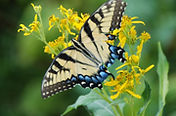Park Activities
Calendar of Events
Volunteer Programs
Sky Meadows Park
Location
Geography
Habitats
Trails
Visiting Park
Crooked Run Valley
Special Projects
pearl crescent (Phyciodes tharos)
CONFIRMATION STATUS: Confirmed.
FAMILY: Brush-footed Butterflies (Nymphalidae)
SUBFAMILY: True Brushfoots (Nymphalinae)
IDENTIFICATION: Quite variable. Males usually have black antennal
knobs. Upperside is orange with black borders; postmedian and
submarginal areas are crossed by fine black marks. Underside of
hindwing has a dark marginal patch containing a light-colored crescent.
Spring and fall broods (form marcia) have a gray mottled hindwing below.
LIFE HISTORY: Males patrol open areas for females. Eggs are laid in small
batches on underside of host plant leaves. Caterpillars eat leaves and are
gregarious when young. Hibernation is by third-stage caterpillars.
FLIGHT: Several broods; from April-November in the north, throughout
the year in the Deep South and Mexico.
WING SPAN: 1 1/4 - 1 3/4 inches (3.2 - 4.5 cm).
CATERPILLAR HOSTS: Several species of smooth-leaved true asters
including Aster pilosus, Aster texanus, and Aster laevis.
ADULT FOOD: Nectar from a great variety of flowers including dogbane,
swamp milkweed, shepherd's needle, asters, and winter cress.
HABITAT: Open areas such as pastures, road edges, vacant lots, fields,
open pine woods.
RANGE: Southeastern Alberta south through Montana, Wyoming,
Colorado, New Mexico, Arizona, and southeastern California to Mexico;
east to southern Ontario and all the eastern United States.
CONSERVATION: Not usually required.
NATURESERVE GLOBAL STATUS: G5 - Demonstrably secure globally,
though it may be quite rare in parts of its range, especially at the
periphery.
MANAGEMENT NEEDS: None reported.
SKY MEADOWS OCCURRENCE:
Note: Due to seasonal conditions in this region, occurrence may vary from
year to year. The designation of occurrence may range over two or more
categories and may vary even during a single season.
Key to Checklist
A Abundant: Easy to see very large numbers of individuals in appropriate habitat
at proper time of year.
C Common: Usually each to see good numbers of individuals in appropriate habitat
at proper time of year.
U Uncommon: Sometimes found in appropriate habitat and proper time of year,
usually in low numbers.
O Occasional: Found in appropriate habitat perhaps only a few times a year, usually
in low numbers.
R Rare: Small chance of being found, even in appropriate habitat at proper time of
year. There are few individuals and may not be present every year.
X Extirpated: Formerly present, no longer occurs in Sky Meadows Park.
January
February
March
April
May
June
July
August
September
October
November
December


